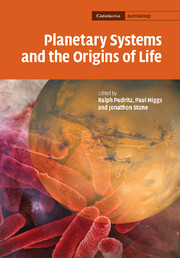Book contents
- Frontmatter
- Contents
- List of contributors
- Preface
- Part I Planetary systems and the origins of life
- Part II Life on Earth
- Part III Life in the Solar System?
- 12 The search for life on Mars
- 13 Life in the dark dune spots of Mars: a testable hypothesis
- 14 Titan: a new astrobiological vision from the Cassini–Huygens data
- 15 Europa, the ocean moon: tides, permeable ice, and life
- Index
14 - Titan: a new astrobiological vision from the Cassini–Huygens data
Published online by Cambridge University Press: 13 August 2009
- Frontmatter
- Contents
- List of contributors
- Preface
- Part I Planetary systems and the origins of life
- Part II Life on Earth
- Part III Life in the Solar System?
- 12 The search for life on Mars
- 13 Life in the dark dune spots of Mars: a testable hypothesis
- 14 Titan: a new astrobiological vision from the Cassini–Huygens data
- 15 Europa, the ocean moon: tides, permeable ice, and life
- Index
Summary
Introduction
The Earth is certainly, so far, the most interesting planetary body for astrobiology since it is still the only one where we are sure that life is present. However, there are many other bodies of astrobiological interest in the Solar System. There are planetary bodies where extraterrestrial life (extinct or extant) may be present, and which thus would offer the possibility of discovering a second genesis, the nature and properties of these extraterrestrial living systems, and the environmental conditions which allowed its development and persistence. Mars and Europa seem to be the best places for such a quest. On the other hand, there are planetary bodies where a complex organic chemistry is going on. The study of such chemistry can help us to better understand the general chemical evolution in the Universe and more precisely the prebiotic chemical evolution on the primitive Earth. Comets are probably the best example, especially considering that their organic content may have also been involved in the prebiotic chemistry on the primitive Earth.
Titan, which is the largest satellite of Saturn, may cover these two complementary aspects and is thus an interesting body for astrobiological research. Moreover, with an environment very rich in organics, it is one of the best targets on which to look for prebiotic chemistry at a full planetary scale. This is particularly important when considering that Titan's environment presents many analogies with the Earth.
- Type
- Chapter
- Information
- Planetary Systems and the Origins of Life , pp. 263 - 284Publisher: Cambridge University PressPrint publication year: 2007



